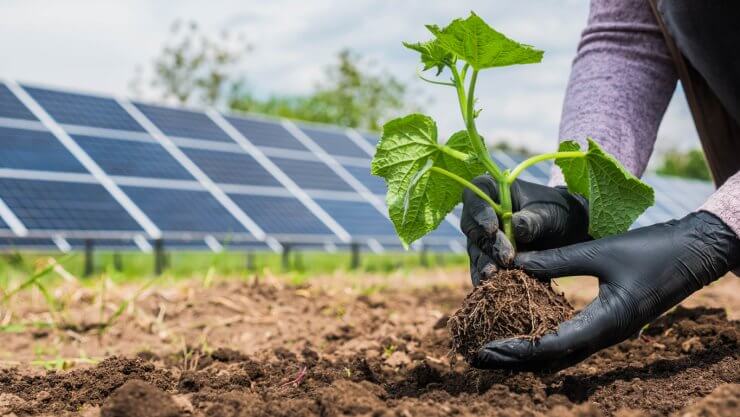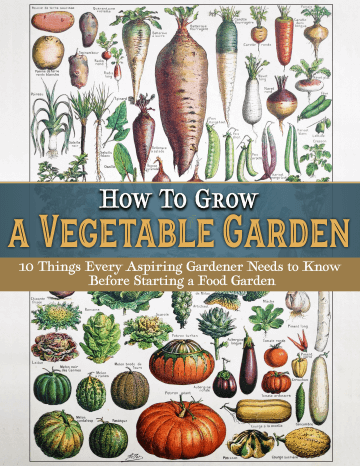
Some of the most innovative solutions to the world’s pressing problems tackle multiple issues. Such is the case with urban gardens powered by renewable energy. Many households struggle with food insecurity that prevents them from getting enough affordable, nutritious meals.
This challenge may mean they skip meals to stay within their budgets or choose junk food too often because it is cheaper and easier to find. Now, some dedicated people and organizations are addressing this issue by planning conveniently placed community gardens.
Discover 10 top tips for growing, harvesting, and enjoying fruits, vegetables, herbs and more from your home garden—when you access the FREEBIE How to Grow a Vegetable Garden, right now!
Urban gardens are not a new idea, but powering them with renewable sources is an emerging trend. These efforts pave the way for a more sustainable future where people can transition away from solar panels and experience a lower risk of food insecurity for themselves and their families.
Revitalizing a London Tube Station
People will be more likely to become interested in and use food gardens if these locations fit into their lives and schedules. If they pass them on the way home from work, university or another place they frequent, that ease of access should boost adoption. That’s why a plan to add a community garden to a London tube station was so thoughtful.
Energy Garden led the project as a volunteer-driven organization that oversaw 20 community gardens at railway stations as of 2024. Community-owned solar is a crucial part of these successful efforts. In this example, landscape designers added bird-friendly gardens to Hillingdon’s Hatton Cross Station.
The site also includes growing plots for residents, making these ideal additions for people who want to try gardening or improve their existing skills when they do not have enough outdoor space at home. An off-grid solar array charges users’ phone batteries and powers the surrounding fairy lights.
Adding gardens to railway stations is an excellent way to improve access to fresh food for communities that need it. Someone who travels through a station daily could take a few extra minutes during each visit to check whether fruits and vegetables are ready to harvest.
The thoughtful decision to add phone-charging capabilities also encourages people to replenish their device batteries while doing a bit of gardening. Solar power is also a fiscally responsible investment for local authorities and others who approve food gardens. Renewable energy can protect people from rising electricity rates when they use what they produce.
Making Farming Accessible to Refugees and Asylum Seekers
Displaced population groups may face above-average risks of food insecurity for numerous reasons. For example, refugees and asylum seekers may not have the right to work in their destination countries, requiring them to survive on very low incomes. Additionally, if they do not speak the local language, learning about their communities and finding the most affordable retailers could be difficult.
A Maine nonprofit addresses these obstacles by providing growing plots to more than 50 refugee and asylum-seeking families who pay modest access fees. Participants can use the land to grow produce to eat or sell, providing them more flexibility as they learn to live in a new place. Though the 62-acre farm is not in an urban area, it is an inspiring example for city-based efforts.
In 2024, the farm got a 20-panel, ground-mount solar array to offset its energy use while increasing the site’s resilience in extreme weather. Estimates suggest this setup will produce 12,000 kilowatt-hours of energy annually, offsetting all the farm’s energy needs.
Many participating families are from numerous African countries, and they have experimented with growing crops that are popular in their home nations. This approach can give them easy access to nutritious foods and ease some of the culture shock that can happen when upheaval forces people to relocate for safety.
Using Solar Panels to Promote Growth
Food insecurity is a complicated, multifaceted issue. Some local authorities believe the best way to combat it is to plan numerous solar-based neighborhoods. One example comes from the U.S. state of Michigan, where Detroit Mayor Mike Duggan has revealed plans for three. They are part of an overarching goal to power municipal buildings with renewable energy. They will collectively provide enough energy for 127 once established.
Additionally, people will create food gardens under the solar panels in two of the three chosen neighborhoods. This approach — known as agrovoltaics — strategically uses the same land for solar energy and food production. Planting crops between or underneath the panels can shelter them from intense weather and allow the young plants to thrive. The third site will instead feature a meadow and community garden, highlighting the various ways to bring new opportunities to urban sites.
Planners are also working with urban farmers, developers and others to ensure equitable access to the grown food. Area residents are also heavily involved in the process, and many have attended dedicated events to give feedback about their community garden preferences.
Statistics have shown that 69.3% of Black communities report food insecurity. That finding emphasizes the importance of reducing the daily barriers minority and marginalized groups face. Requesting ongoing input from residents will get their buy-in in the projects and should increase their desire to participate. This approach of having solar power and community gardens share the land will also help groups leading other projects see what’s possible, especially if they lack ample space.
Improving Food Access and Clean Energy Use
These inspiring examples show the options for simultaneously addressing food insecurity while prioritizing renewable energy in the planned gardens. Hearing about what others have done could encourage others to determine whether similar efforts would enrich their communities.
Discover 10 top tips for growing, harvesting, and enjoying fruits, vegetables, herbs and more from your home garden—when you access the FREEBIE How to Grow a Vegetable Garden, right now!




